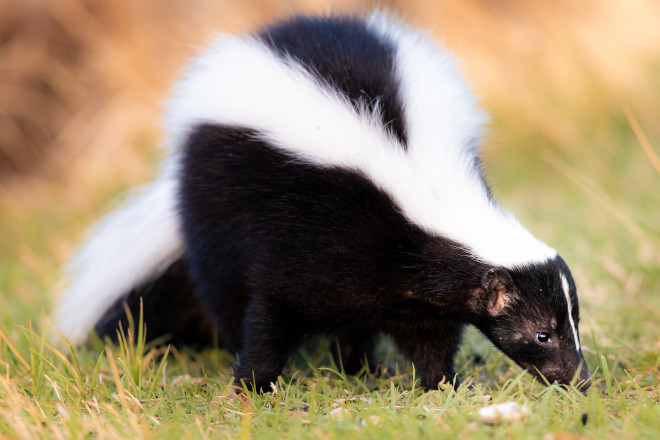Skunks are one of the few animals everyone recognizes with their blatant and easy-to-see lateral white stripes across its body. However skunks can come in a variety of shades and while local skunks to certain parts of North America tend to look very different they are all joined by the presence of a white stripe, or two, on their back or sides. This strip almost always present at birth and is a signifier that is rarely used by north American mammals. Arachnids use coloured strips to warn of their venom. The skunk is similar in that its stripe warns onlookers and predators alike that dealing with this animal is a mistake. How did they get it? Likely through evolution. Skunks without a signifier would be killed even if they sprayed but when some skunks started being born with stripes they would ward of predators with their aesthetic appearance instead of with a threatening demeanour. This is the reason skunks are plodding and do not mind sitting out in the open without fear. They are aware that any enemy that sees them, including humans will run away at first glance.
Skunks can have jet black fur but they can also have brown fur, grey fur and even some cream-coloured skunks. They do differ in appearance a great deal, unlike raccoons who often fool humans into thinking the same one has been coming to the property to defecate for years when in truth it has been many different raccoons over that time. With skunks, you will likely recognize them straight away and will likely be able to differentiate them from their fellows. They tend to be the size of an adult cat and have long aggressive claws on their relatively large feet that make them extremely adept diggers. They are not good climbers. Skunks will almost always choose to burrow over climbing into an attic. The greatest danger a skunk can offer a property is burrowing under a structure. While open burrows can be dealt with in various ways when they get under a structure they become impossible to deal with. This can be resolved but it takes some work. Getting a skunk off from under a deck or shed requires a process called trenching. The process involves digging one foot by six-inch trench around the base of the structure keeping tight the structure itself. Attach waterproof galvanized steel mesh to the side of the bottom of the structure, encapsulating its perimeter fully and then burry the mesh one foot down and six inches out. This will prevent them from getting under it in the first place but if there is an animal still under there you will need something else. Go to a hardware store and buy a device called a wildlife one-way door. It allows an animal to vacate but prevents it from getting back in. It is usually made of steel and looks like a cage with an open end, or for larger animals a spring-loaded doggy door. This will allow the animal out and allow you to finish the trenching and exclude all animals from your deck, shed or gazebo. Call Skunk Control for help.

